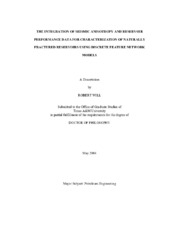| dc.description.abstract | This dissertation presents the development of a method for quantitative integration of seismic (elastic) anisotropy attributes with reservoir performance data as an aid in characterization of systems of natural fractures in hydrocarbon reservoirs. This new method incorporates stochastic Discrete Feature Network (DFN) fracture modeling techniques, DFN model based fracture system hydraulic property and elastic anisotropy modeling, and non-linear inversion techniques, to achieve numerical integration of production data and seismic attributes for iterative refinement of initial trend and fracture intensity estimates. Although DFN modeling, flow simulation, and elastic anisotropy modeling are in themselves not new technologies, this dissertation represents the first known attempt to integrate advanced models for production performance and elastic anisotropy in fractured reservoirs using a rigorous mathematical inversion. The following new developments are presented:
. • Forward modeling and sensitivity analysis of the upscaled hydraulic properties of realistic DFN fracture models through use of effective permeability modeling techniques.
. • Forward modeling and sensitivity analysis of azimuthally variant seismic attributes based on the same DFN models.
. • Development of a combined production and seismic data objective function and computation of sensitivity coefficients.
. • Iterative model-based non-linear inversion of DFN fracture model trend and intensity through minimization of the combined objective function.
This new technique is demonstrated on synthetic models with single and multiple fracture sets as well as differing background (host) reservoir hydraulic and elastic properties. Results on these synthetic control models show that, given a well conditioned initial DFN model and good quality field production and seismic observations, the integration procedure results in convergence of both fracture trend and intensity in models with both single and multiple fracture sets. Tests show that for a single fracture set convergence is accelerated when the combined objective function is used as compared to a similar technique using only production data in the objective function. Tests performed on multiple fracture sets show that, without the addition of seismic anisotropy, the model fails to converge. These tests validate the importance of the new process for use in more realistic reservoir models. | en |


